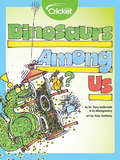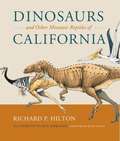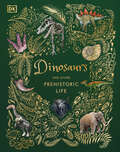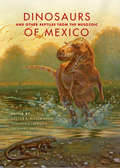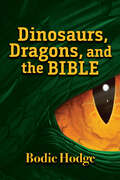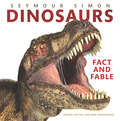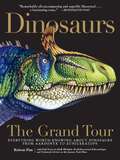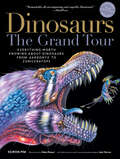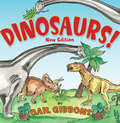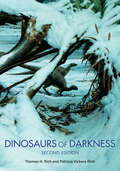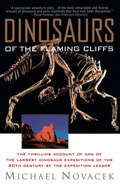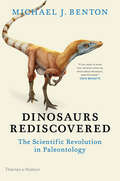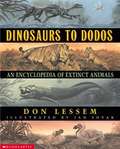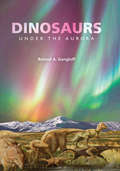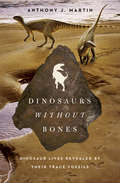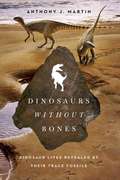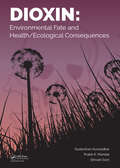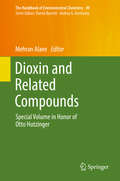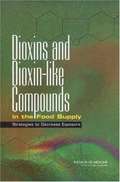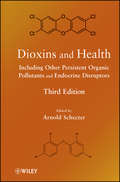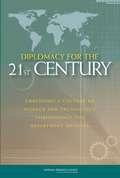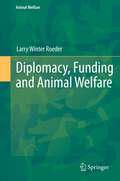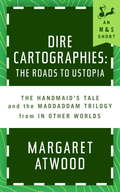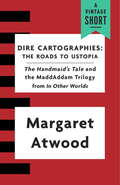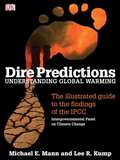- Table View
- List View
Dinosaurs Among Us
by Dr Gary GalbreathThere are dinosaurs still around today. We call them "birds."
Dinosaurs and Other Mesozoic Reptiles of California
by Richard P. Hilton Ken KirklandOne of the most geologically complex and diverse states, California spent much of the age of dinosaurs under water. While most of the fossils found in the state are those of reptiles that lived in the sea (thalattosaurs, ichthyosaurs, mosasaurs, plesiosaurs, and turtles), some are those of birds and pterosaurs that soared above it. Other fossils come from terrestrial animals that died and were washed into the ocean. These include turtles, crocodiles, lizards, and dinosaurs such as armored ankylosaurs, duck-billed hadrosaurs, and a variety of carnivorous dinosaurs. Richard Hilton is the first to tell the unsung story of the dinosaurs and reptiles of land, sea, and sky that lived in California and Baja California during the Mesozoic era (245 million-65 million years ago), in addition to the history of their discovery. Vibrantly illustrated with more than three hundred photographs, paintings, and drawings, this book provides geological and environmental details, describes the significance of the major fossils, and chronicles the adventures involved in the discovery, preparation, and publishing of the finds. Hilton also includes accounts of the scientists, teachers, students, ranchers, and weekend fossil hunters who endured (and continue to endure) harsh weather, fires, wild animals, and the usual challenges of fieldwork to collect fossil remains and make major discoveries. These enthusiasts managed to safeguard an abundance of fossil resources, some of which would otherwise have been destroyed by quarrying, paving, and housing developments. Dinosaurs and Other Mesozoic Reptiles of California takes this legacy one step further by documenting information about the fossils and their finders in accessible prose and vivid artistic renderings, creating a valuable contribution to our understanding of California's prehistoric past.
Dinosaurs and Other Prehistoric Life (DK Children's Anthologies)
by Professor Anusuya Chinsamy-TuranA comprehensive pocket guide to dinosaurs and prehistoric animals and the world they inhabited millions of years ago. Packed with more than seven hundred full-color illustrations, this definitive pocket guide paints a vivid portrait of extraordinary dinosaurs and prehistoric animals, and the ecosystems they lived in millions of years ago. This guide features authoritative text, crystal-clear illustrations, and a straightforward approach to revealing the fascinating lives and habitats of dinosaurs, pterosaurs, marine reptiles, and prehistoric beasts. The introductory section explains classification systems, geological timelines, the evolution of the dinosaurs, and how fossils form and are discovered by paleontologists. For ease of reference, the main body of the book is divided into three sections: the Precambrian and Paleozoic eras, when animals first began evolving; the Mesozoic era, which saw the flourishing and eventual extinction of the dinosaurs; and the Cenozoic era, when giant mammals walked the Earth. Each section is broken down into its geological time periods, and, within these, the species are organized according to habitat--whether they lived on land, in the water, or in the air.There are detailed profiles of 200 dinosaurs and other ancestors of modern animals. Each entry combines a precise, jargon-free description with full-color illustrations, skeletons, and replica models, annotated to showcase the unique features of the species. Maps show where each animal's fossils have been found, and many profiles are supported by photographs to show actual excavation sites.
Dinosaurs and Other Reptiles from the Mesozoic of Mexico
by Héctor E. Rivera-Sylva Eberhard Frey Kenneth CarpenterThis overview of dinosaur discoveries in Mexico synthesizes current information about the geography and environment of the region during the Mesozoic when it was the western margin of the ancient continent of Pangea. The book summarizes research on various groups, including turtles, lepidosauromorphs, plesiosaurs, crocodyliforms, pterosaurs, and last but not least, dinosaurs. In addition, chapters focus on trackways and other trace fossils and on K/P boundary (the Chicxulub crater, beneath the Gulf of Mexico, has been hypothesized as the site of the boloid impact that killed off the dinosaurs). Dinosaurs and Other Reptiles from the Mesozoic of Mexico is an up-to-date, informative volume on an area that has not been comprehensively described until now.
Dinosaurs, Dragons, and the Bible
by Bodie HodgeDinosaurs, Dragons, and the Bible is a one-of-a kind Christian apologetic resource sure to captivate families, scientists, historians, and theologians! Using the Bible as the absolute authority, Bodie Hodge of Answers in Genesis, the Creation Museum, and the Ark Encounter, provides answers to the most asked questions about these amazing creatures. As Christians, we must not ignore what the Scriptures say about dinosaurs and dragons and accept the secular world’s wisdom. This #ProBible handbook offers fascinating answers based on fossil footprints, soft tissue, biblical references to dragons, serpents, and leviathans, and much more. Go beyond the Hollywood version of these magnificent creatures to discover the truth of these icons of Creation and testaments of God’s power in the Genesis Flood. Designed for almost all ages, the book answers questions such as: How Did Huge Dinosaurs Fit on the Ark? Are Dinosaurs and Dragons the Same Thing? How Do I Use the Bible as the Framework to Look at Dinosaurs? Were Dinosaurs on Noah’s Ark (and Did Any Go Extinct Before the Flood)? Are Dinosaur Fossils in the Cretaceous, Jurassic, and Triassic Rock Millions of Years Old or from the Flood? Why Don’t We Find the Word “Dinosaur” in the Bible? Are There Any Human and Dinosaur Fossils Buried Together? Dinosaurs are nearly synonymous with evolution in the minds of much of the world. Studying these answers will help Christian families, church leaders, scientists, and theologians develop greater faith in the infallibility of God’s Word and His role as Creator. A Note from the author, Bodie Hodge: “I want to encourage parents and churches to be able to respond biblically to the secular attacks (war) on our children. So, as any good General would do in times of war, we need to study our opponent and know exactly what the secular side is teaching our children. Then, get equipped with solid biblical answers from our highest commanding officer (God and His Word) to defend our children against the attacks. Then, teach this knowledge diligently and apologetically to the next generation, like parents and churches are supposed to do (e.g., Ephesians 6:4-11, 2 Timothy 3:16–17).”
Dinosaurs: Fact and Fable
by Seymour Simon“If you love dinosaurs, you’ll love this book."— Steve Brusatte, paleontologist at the University of Edinburgh and New York Times bestselling author of The Rise and Fall of the DinosaursJoin award-winning science writer Seymour Simon as he separates fact from fiction in a brilliant exploration of some of the most fascinating creatures to ever roam the planet: dinosaurs! This nonfiction picture book is an excellent choice for both shared and independent reading during homeschooling and classroom learning, in particular for children ages 6 to 8.Scientists have dug up and uncovered many facts about dinosaurs—and in the process, they have come across many myths. This picture book digs deep into the Age of Dinosaurs, covering topics such as fossilization, plate tectonics, dinosaur diets, paleontology, extinction theories, dinosaur relatives, and more!Get ready to learn what we know about dinosaurs and what we still don’t know, and about the amazing new discoveries being made every single day.Perfect for young scholars’ school reports, Dinosaurs: Fact and Fable features clear text, vibrantly colored pages, engaging sidebars, and stunning full-color illustrations and photographs. This book includes an author's note, a glossary, a timeline, and an index and supports the Common Core State Standards.Check out these other Seymour Simon books about animals:Big CatsButterfliesCatsCrocodiles & AlligatorsDogsDolphinsElephantsFrogsGorillasHorsesInsectsPenguinsSea CreaturesSnakesSpidersWhalesWild BabiesWolves
Dinosaurs - The Grand Tour: Everything Worth Knowing About Dinosaurs from Aardonyx to Zuniceratops
by Keiron Pim Jack HornerFrom Aardonyx to Zuniceratops—A Dino-Mite Gathering of All the Dinosaurs (More Than 300!) Worth Knowing About We live in a golden age of paleontological discovery—the perfect time to dig in to the spectacular world of dinosaurs. From Aardonyx, a lumbering beast that formed a link between two and four-legged dinosaurs, to Zuniceratops, who boasted a deadly pair of horns, Dinosaurs—The Grand Tour details everything worth knowing about every important dinosaur that scientists know about—more than 300 in all. In Dinosaurs you’ll learn all the gory details—about geology, anatomy, evolution, astronomy, and even Native American and Chinese mythology. Stories of harrowing paleontological expeditions conjure the thrills of history’s most famous dinosaur hunters. Highlights of recent research reveal what’s going on in the world of dinosaurs today, including scientists’ recent discovery of pigments embedded in dinosaur fossils that shed light, for the first time, on dinosaurs’ true coloration. Illustrations on virtually every page bring these prehistoric creatures to life in all their razor-sharp, long-necked, spiny, scaly glory. And for readers inspired to test their dino-expertise in the field, renowned paleontologist Jack Horner’s field notes will help enthusiasts set out on their own expeditions. Track down dinosaur footprints at Horner’s recommended sites, head out on a cross-country dinosaur road trip using Horner’s list of top North American dinosaurs as your map, and learn what it’s like to be a leading paleontologist who’s been part of some of the most sensational dinosaur discoveries ever—and how you can get involved, too!
Dinosaurs - The Grand Tour, Second Edition (Second): Everything Worth Knowing About Dinosaurs From Aardonyx To Zuniceratops
by Keiron PimBigger and Better, Updated and Expanded We live in a golden age of paleontological discovery—on average, we find one new dinosaur species per week. The most fascinating among them take their place in this updated edition of Dinosaurs—The Grand Tour; from Aardonyx, a lumbering beast that formed a link between two- and four-legged dinosaurs, to Zuniceratops, who boasted a deadly pair of horns. Here, you’ll find everything worth knowing about every dinosaur worth knowing—more than 300 in all, including: Amphibious Halszkaraptor looks like no other dinosaur we’ve found—with a head and body the size of a duck’s, sharp claws . . . and a swanlike neck. Longer than a blue whale and three times taller than a giraffe, Patagotitan is a newly discovered contender for “biggest dinosaur ever.” The speedy little feathered predator Stenonychosaurus was an anatomical marvel, with retractable claws, asymmetrical ears for advanced hearing, incredible night vision, and a huge brain. Oviraptor—whose name means “egg thief “—doesn’t deserve its bad rap. This specimen from 1923 is now proven to have been sitting by its own eggs—not stealing another’s. Sinornithosaurus prove that dinosaurs shed their skin the same way that humans do, rather than sloughing it off all at once like a snake. At-a-glance sidebars put each dinosaur’s diet, size, and location at your fingertips. Stories of harrowing expeditions conjure the thrills of history’s most famous dinosaur hunters. Highlights from recent research reveal what’s new in paleontology today, including scientists’ evolving idea of what dinosaurs actually looked like. (Hint: They were more colorful—and feathery!—than we ever thought before.) And illustrations on virtually every page bring these prehistoric creatures to life in all their glory.
Dinosaurs! (New & Updated): Second Edition
by Gail GibbonsA giant meteor blasts an enormous crater into Earth's surface, causing the end of what scientists call the Age of Dinosaurs. Gail Gibbons presents the most recent and up-to-date theories about the history of dinosaurs and dinosaur discoveries. She discusses the Triassic, Jurassic, and Cretaceous periods and the non-bird dinosaurs that lived during each time. Each dinosaur is explored in just the right amount of detail for young paleontologists, as this book brings these magnificent creatures to life again. Gail Gibbons's books have won many honors, including the Washington Post/Children's Book Guild Nonfiction Award and the NSTA Outstanding Science Trade Book awards.
Dinosaurs of Darkness: In Search of the Lost Polar World (Life of the Past)
by Thomas H. Rich Patricia Vickers-Rich&“A valuable volume detailing an underexplored region of the world of dinosaurs . . . essential reading for any dino-devotee.&” —ForeWordDinosaurs of Darkness opens a doorway to a fascinating former world, between 100 million and 120 million years ago, when Australia was far south of its present location and joined to Antarctica. Dinosaurs lived in this polar region. How were the polar dinosaurs discovered? What do we now know about them? Thomas H. Rich and Patricia Vickers-Rich, who have played crucial roles in their discovery, describe how they and others collected the fossils indispensable to our knowledge of this realm and how painstaking laboratory work and analyses continue to unlock the secrets of the polar dinosaurs. This scientific adventure makes for a fascinating story: it begins with one destination in mind and ends at another, arrived at by a most roundabout route, down byways and back from dead ends. Dinosaurs of Darkness is a personal, absorbing account of the way scientific research is actually conducted and how hard—and rewarding—it is to mine the knowledge of this remarkable life of the past. The award-winning first edition has now been thoroughly updated with the latest discoveries and interpretations, along with over 100 new photographs and charts, many in color.
Dinosaurs of the Flaming Cliff
by Michael NovacekOver the past six years Michael Novacek, the Provost of Science at the American Museum of Natural History, has led a team of international scientists to the Gobi Desert on the greatest dinosaur expedition of the late 20th century. Closed to the West since the 1920's, the remote sands of Mongolia's Gobi Desert constitute the richest fossil site in the world. In Dinosaurs of the Flaming Cliffs, Novacek invites the reader along with his team as he recounts the day-to-day drama of field exploration and discusses the remarkable discoveries that he and his colleagues unearthed, fossil finds that have helped to reshape our understanding of the dinosaur and early mammal era. Interweaving the adventure of field research with chapters that bring the reader up to date on contemporary dinosaur theory and science, Dinosaurs of the Flaming Cliffs brings the excitement of scientific discovery to life.From the Trade Paperback edition.
Dinosaurs Rediscovered: The Scientific Revolution In Paleontology
by Michael J. BentonIn this fascinating and accessible overview, renowned paleontologist Michael J. Benton reveals how our understanding of dinosaurs is being transformed by recent fossil finds and new technology. Over the past twenty years, the study of dinosaurs has transformed into a true scientific discipline. New technologies have revealed secrets locked in prehistoric bones that no one could have previously predicted. We can now work out the color of dinosaurs, the force of their bite, their top speeds, and even how they cared for their young. Remarkable new fossil discoveries—giant sauropod dinosaur skeletons in Patagonia, dinosaurs with feathers in China, and a tiny dinosaur tail in Burmese amber—remain the lifeblood of modern paleobiology. Thanks to advances in technologies and methods, however, there has been a recent revolution in the scope of new information gleaned from such fossil finds. In Dinosaurs Rediscovered, leading paleontologist Michael J. Benton gathers together all the latest paleontological evidence, tracing the transformation of dinosaur study from its roots in antiquated natural history to an indisputably scientific field. Among other things, the book explores how dinosaur remains are found and excavated, and especially how paleontologists read the details of dinosaurs’ lives from their fossils—their colors, their growth, and even whether we will ever be able to bring them back to life. Benton’s account shows that, though extinct, dinosaurs are still very much a part of our world.
Dinosaurs To Dodos: An Encyclopedia Of Extinct Animals
by Don Lessem Jan SovakFrom the first microscopic sea creatures to the Tasmanian wolf, this book traces all of extinct life. Each chapter covers the animals themselves, the processes that brought them to extinction, and the modern scientific discoveries that reveal their lost worlds.
Dinosaurs under the Aurora
by Roland A. GangloffIn 1961, while mapping rock exposures along the Colville River in Alaska, an oil company geologist would unknowingly find the evidence for a startling discovery. Long before the North Slope of Alaska was being exploited for its petroleum resources it was a place where dinosaurs roamed. Dinosaurs under the Aurora immerses readers in the challenges, stark beauty, and hard-earned rewards of conducting paleontological field work in the Arctic. Roland A. Gangloff recounts the significant discoveries of field and museum research on Arctic dinosaurs, most notably of the last 25 years when the remarkable record of dinosaurs from Alaska was compiled. This research has changed the way we think about dinosaurs and their world. Examining long-standing controversies, such as the end-Cretaceous extinction of dinosaurs and whether dinosaurs were residents or just seasonal visitors to polar latitudes, Gangloff takes readers on a delightful and instructive journey into the world of paleontology as it is conducted in the land under the aurora.
Dinosaurs Without Bones: Dinosaur Lives Revealed by Their Trace Fossils
by Anthony J. MartinWhat if we woke up one morning all of the dinosaur bones in the world were gone? How would we know these iconic animals had a 165-million year history on earth, and had adapted to all land-based environments from pole to pole? What clues would be left to discern not only their presence, but also to learn about their sex lives, raising of young, social lives, combat, and who ate who? What would it take for us to know how fast dinosaurs moved, whether they lived underground, climbed trees, or went for a swim?Welcome to the world of ichnology, the study of traces and trace fossils--such as tracks, trails, burrows, nests, toothmarks, and other vestiges of behavior--and how through these remarkable clues, we can explore and intuit the rich and complicated lives of dinosaurs. With a unique, detective-like approach, interpreting the forensic clues of these long-extinct animals that leave a much richer legacy than bones, Martin brings the wild world of the Mesozoic to life for the twenty-first-century reader.
Dinosaurs Without Bones: Dinosaur Lives Revealed by Their Trace Fossils
by Anthony J. Martin"Bubbles over with the joy of scientific discovery as he shares his natural enthusiasm for the blend of sleuthing and imagination."—Publishers Weekly, starred reviewWhat if we woke up one morning all of the dinosaur bones in the world were gone? How would we know these iconic animals had a165-million year history on earth, and had adapted to all land-based environments from pole to pole? What clues would be left to discern not only their presence, but also to learn about their sex lives, raising of young, social lives, combat, and who ate who? What would it take for us to know how fast dinosaurs moved, whether they lived underground, climbed trees, or went for a swim?Welcome to the world of ichnology, the study of traces and trace fossils – such as tracks, trails, burrows, nests, toothmarks, and other vestiges of behavior – and how through these remarkable clues, we can explore and intuit the rich and complicated lives of dinosaurs. With a unique, detective-like approach, interpreting the forensic clues of these long-extinct animals that leave a much richer legacy than bones, Martin brings the wild world of the Mesozoic to life for the 21st century reader.
Dioxin: Environmental Fate and Health/Ecological Consequences
by Sudarshan Kurwadkar Prabir K. Mandal Shivani SoniDioxin – Environmental Fate and Health/Ecological Consequences offers a unique, and comprehensive coverage of dioxins and their congeners once they are released to the environment. The book provides readers with a systematic understanding of past and emerging sources of dioxins, current dioxins inventories and historical trends, fate and long-range transboundary atmospheric transport, human health, and ecological risk and regulatory perspective. Providing an excellent analysis of dioxin exposure through the food chain and impact on human health, it also documents the environmental implications of dioxins on ecological flora and fauna. The book offers readers a holistic understanding about dioxins, their atmospheric fate and transport, distribution in various environmental matrices and various routes and exposure pathways through which human beings are exposed to this persistent organic pollutant. It further offers an insight into the toxicological profile and mechanistic analysis of the onset of cancer, remediation technologies, and existing regulatory framework to deal with the problems associated with dioxins. The book will serve as an excellent resource to environmental professionals, particularly environmental toxicologists, environmental health professionals, remediation engineers, environmental regulatory agencies, policymakers, and environmental law professionals.
Dioxin and Related Compounds
by Mehran AlaeeThis volume is a tribute to Professor Otto Hutzinger, the founding editor of The Handbook of Environmental Chemistry, in recognition of his pioneering work and contribution to our understanding of the sources, fate, exposure and effects of persistent organic pollutants. It consists of fourteen chapters written by individuals who have been inspired by his work and have followed in his footsteps by refining our knowledge of this field and opening new research directions. In Professor Hutzinger's tradition of passing on valuable information to others, the authors present recent advances in areas such as inventories, remediation, and analytical determinations. Levels and trends in abiotic environments, biota, and human exposure via food, as well as the risks to the environment and humans from polychlorinated dibenzo dioxins, furans, and PCBs are also discussed. Other chapters deal with the relevant topics of DDT and its metabolites along with halogenated and phosphorus flame retardants.
Dioxins and Dioxin-like Compounds in the Food Supply: Strategies to Decrease Exposure
by Committee on the Implications of Dioxin in the Food SupplyDioxin and dioxin-like compounds, or DLCs, are found throughout the environment, in soil, water, and air. People are exposed to these unintentional environmental contaminants primarily through the food supply, although at low levels, particularly by eating animal fat in meat, dairy products, and fish. While the amount of DLCs in the environment has declined since the late 1970s, the public continues to be concerned about the safety of the food supply and the potential adverse health effects of DLC exposure, especially in groups such as developing fetuses and infants, who are more sensitive to the toxic effects of these compounds. Dioxins and Dioxin-like Compounds in the Food Supply: Strategies to Decrease Exposure, recommends policy options to reduce exposure to these contaminants while considering how implementing these options could both reduce health risks and affect nutrition, particularly in sensitive and highly exposed groups, if dietary changes are suggested.
Dioxins and Health: Including Other Persistent Organic Pollutants and Endocrine Disruptors
by Arnold SchecterExplores the latest science on dioxins and other POPs, and their impact on human health Now in its third edition, Dioxins and Health is the most respected reference of its kind, presenting the latest scientific findings on dioxins, dibenzofurans, polychlorinated biphenyls and related compounds, and their impact on human health. The book fully examines the many toxicological effects-including immunological, neurological, developmental, dermatological, and cardiological-these chemicals have on health. This Third Edition has been greatly expanded with the latest research findings on dioxins and related compounds. Moreover, it now includes coverage of other persistent organic pollutants (POPs) and endocrine disruptors, including: Brominated flame retardants, such as polybrominated diphenyl ethers and hexabromocyclododecane Perfluorinated chemicals such as perfluorooctanoic acid and perfluorooctanesulfonic acid Other endocrine disrupting chemicals similar to POPs such as bisphenol A Readers will also learn about the latest findings on the long-term impacts caused by the use of Agent Orange in Vietnam. Other chapters review the Seveso disaster in Italy and the Yusho and Yucheng rice oil poisoning incidents in Japan and Taiwan. In addition, there is a full chapter dedicated to the dioxin poisoning of former Ukraine President Victor Yushchenko. All the chapters in the book have been written by leading international experts. References at the end of each chapter guide readers to the primary literature in the field. Expertly organized in one volume, Dioxins and Health offers readers quick access to essential information about dioxins and related compounds written in clear, simple language that is accessible to not only scientists, clinicians and public health professionals, but also general readers.
Diplomacy for the 21st Century: Embedding a Culture of Science and Technology Throughout the Department of State
by Committee on Science Technology Capabilities at the Department of State"Diplomacy for the 21st Century" recommends steps that the Department of State should embrace to take full advantage of the leading science and technology (S&T) capabilities of the United States. These capabilities provide the department with many opportunities to promote a variety of the interests of the United States and its allies in a rapidly changing world wherein S&T are important drivers of economic development at home and abroad and help ensure international security. This report assesses and makes recommendations concerning the changing environment for the conduct of diplomacy in the years ahead, with a focus on the role of S&T in the development and implementation of U. S. policies and programs. According to this report, prompt steps by the department's leadership are essential to ensure adequate comprehension of the importance of S&T-related developments throughout the world and to incorporate this understanding within the nation's foreign policy for the 21st century. This report also urges the adoption by the department of a broader whole-of-society approach in carrying out its responsibilities at home and abroad - extending beyond traditional interagency coordination and the narrow band of current external partners to include foundations, universities, research centers, and other groups who are extending their international reach.
Diplomacy, Funding and Animal Welfare
by Larry Winter Roeder Jr.Diplomacy, Funding and Animal Welfare is a practical guide to the best diplomatic and negotiation practices needed to convince governments and international institutions to effectively protect animals, which also introduces new approaches to fundraising. Animal protection advocates are prepared for speaking to diplomats and government officials in any setting, and to combatants in war zones. The book mainly focuses on approaching local and national governments, the United Nations system, the international Red Cross movement and systems related to other international organizations that can help animals, often in surprising ways. The reader will learn the rules of "diplomatic protocol", and much about the rules and procedures of major international bodies. To provide balance and real world relevance, the guide draws on a compilation of the author's extensive activities across a range of development, animal welfare, emergency management and climate issues in government and in the NGO world, as well as interviews with scholars and officials from NGOs, diplomatic missions, the United Nations, the Red Cross, governments and corporations.
Dire Cartographies
by Margaret AtwoodIn honor of the thirtieth anniversary of The Handmaid's Tale: Margaret Atwood describes how she came to write her utopian, dystopian works. The word "utopia" comes from Thomas More's book of the same name--meaning "no place" or "good place,"" or both. In "Dire Cartographies," from the essay collection In Other Worlds, Atwood coins the term "ustopia,"" which combines utopia and dystopia, the imagined perfect society and its opposite. Each contains latent versions of the other. Following her intellectual journey and growing familiarity with ustopias fictional and real, from Atlantis to Avatar and Beowulf to Berlin in 1984 (and 1984), Atwood explains how years after abandoning a PhD thesis with chapters on good and bad societies, she produced novel-length dystopias and ustopias of her own. "My rules for The Handmaid's Tale were simple," Atwood writes. "I would not put into this book anything that humankind had not already done, somewhere, sometime, or for which it did not already have the tools." With great wit and erudition, Atwood reveals the history behind her beloved creations.
Dire Cartographies: The Roads to Ustopia and The Handmaid's Tale (A Vintage Short)
by Margaret AtwoodIn honor of the thirtieth anniversary of The Handmaid's Tale: Margaret Atwood describes how she came to write her utopian, dystopian works. The word "utopia" comes from Thomas More's book of the same name--meaning "no place" or "good place," or both. In "Dire Cartographies," from the essay collection In Other Worlds, Atwood coins the term "ustopia," which combines utopia and dystopia, the imagined perfect society and its opposite. Each contains latent versions of the other. Following her intellectual journey and growing familiarity with ustopias fictional and real, from Atlantis to Avatar and Beowulf to Berlin in 1984 (and 1984), Atwood explains how years after abandoning a PhD thesis with chapters on good and bad societies, she produced novel-length dystopias and ustopias of her own. "My rules for The Handmaid's Tale were simple," Atwood writes. "I would not put into this book anything that humankind had not already done, somewhere, sometime, or for which it did not already have the tools." With great wit and erudition, Atwood reveals the history behind her beloved creations.
Dire Predictions
by Michael Mann Lee R. KumpInformation on global climate change drawn from the Fourth Assessment Report of the Intergovernmental Panel on Climate Change (IPCC).
